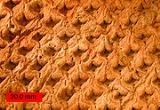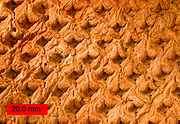
Lepidodendrales
Encyclopedia
Lepidodendrales were primitive, vascular, arborescent (tree
-like) plant
s related to the lycopsids (club mosses). They thrived during the Carboniferous
period, and some reached heights of over 30 meters, with trunks often more than one meter in diameter. Sometimes called "giant club mosses", they are in fact more closely related to quillwort
s than to club mosses.
. These leaves were long and narrow, similar to large blades of grass, and were spirally-arranged. The vascular system of the erect trunk was unusual in that it switched its morphological development as the plant grew. The young trunk began as a protostele in which the outer xylem
matured first (exarch), but the later and higher portion of the trunk developed as an ectophloic
siphonostele in which the xylem
was flanked by phloem
tissue on both its inner and outer side.
The closely packed diamond-shaped leaf scars left on the trunk and stems as the plant grew provide some of the most interesting and common fossil
s in Carboniferous shale
s and accompanying coal
deposits. These fossils look much like tire tracks or alligator
skin.
 The scars, or leaf cushions, were composed of green photosynthetic
The scars, or leaf cushions, were composed of green photosynthetic
tissue, evidenced by the cuticle covering and being dotted with stomata, microscopic pores through which carbon dioxide
from the air diffuses into plants. Likewise, the trunks of Lepidodendrons would have been green, unlike modern trees which have scaly, non-photosynthetic brown or gray bark.
The architecture of the lepidodendrales has been called "cheap". The trunks produced very little, if any, wood. Most structural support came from a thick, bark-like region. This region remained around the trunk as a rigid layer that did not flake off like that of most modern trees. As the tree grew, the leaf cushions expanded to accommodate the increasing width of the trunk.
The branches of these plants ended in cone-like structures. They did not produce seed
s like many modern plants. Instead, it reproduced by means of spore
s. It is estimated that these plants grew rapidly and lived 10–15 years. Some species were probably monocarpic, meaning they reproduced only once toward the end of their life cycle.
, Lepidophloios, and Sigillaria
, distinguished on the basis of the ratio of scale width to height - they are otherwise identical. In addition, many "organ taxa" have been identified to the lepidodendrales: each root (Stigmaria
), leaf and cone (Lepidostrobus) was originally given a different genus and species name before it could be shown that they belonged to the same organism.
Tree
A tree is a perennial woody plant. It is most often defined as a woody plant that has many secondary branches supported clear of the ground on a single main stem or trunk with clear apical dominance. A minimum height specification at maturity is cited by some authors, varying from 3 m to...
-like) plant
Plant
Plants are living organisms belonging to the kingdom Plantae. Precise definitions of the kingdom vary, but as the term is used here, plants include familiar organisms such as trees, flowers, herbs, bushes, grasses, vines, ferns, mosses, and green algae. The group is also called green plants or...
s related to the lycopsids (club mosses). They thrived during the Carboniferous
Carboniferous
The Carboniferous is a geologic period and system that extends from the end of the Devonian Period, about 359.2 ± 2.5 Mya , to the beginning of the Permian Period, about 299.0 ± 0.8 Mya . The name is derived from the Latin word for coal, carbo. Carboniferous means "coal-bearing"...
period, and some reached heights of over 30 meters, with trunks often more than one meter in diameter. Sometimes called "giant club mosses", they are in fact more closely related to quillwort
Quillwort
Isoëtes, also written Isoetes and commonly known as the quillworts, is a genus of plants in the class Isoetopsida and order Isoetales. They are considered "fern allies". There are about 140-150 species, with a cosmopolitan distribution but often scarce to rare...
s than to club mosses.
Morphology
Lepidodendrales had tall, thick trunks that rarely branched and were topped with a crown of bifurcating branches bearing clusters of leavesLeaf
A leaf is an organ of a vascular plant, as defined in botanical terms, and in particular in plant morphology. Foliage is a mass noun that refers to leaves as a feature of plants....
. These leaves were long and narrow, similar to large blades of grass, and were spirally-arranged. The vascular system of the erect trunk was unusual in that it switched its morphological development as the plant grew. The young trunk began as a protostele in which the outer xylem
Xylem
Xylem is one of the two types of transport tissue in vascular plants. . The word xylem is derived from the Classical Greek word ξυλον , meaning "wood"; the best-known xylem tissue is wood, though it is found throughout the plant...
matured first (exarch), but the later and higher portion of the trunk developed as an ectophloic
Phloem
In vascular plants, phloem is the living tissue that carries organic nutrients , in particular, glucose, a sugar, to all parts of the plant where needed. In trees, the phloem is the innermost layer of the bark, hence the name, derived from the Greek word "bark"...
siphonostele in which the xylem
Xylem
Xylem is one of the two types of transport tissue in vascular plants. . The word xylem is derived from the Classical Greek word ξυλον , meaning "wood"; the best-known xylem tissue is wood, though it is found throughout the plant...
was flanked by phloem
Phloem
In vascular plants, phloem is the living tissue that carries organic nutrients , in particular, glucose, a sugar, to all parts of the plant where needed. In trees, the phloem is the innermost layer of the bark, hence the name, derived from the Greek word "bark"...
tissue on both its inner and outer side.
The closely packed diamond-shaped leaf scars left on the trunk and stems as the plant grew provide some of the most interesting and common fossil
Fossil
Fossils are the preserved remains or traces of animals , plants, and other organisms from the remote past...
s in Carboniferous shale
Shale
Shale is a fine-grained, clastic sedimentary rock composed of mud that is a mix of flakes of clay minerals and tiny fragments of other minerals, especially quartz and calcite. The ratio of clay to other minerals is variable. Shale is characterized by breaks along thin laminae or parallel layering...
s and accompanying coal
Coal
Coal is a combustible black or brownish-black sedimentary rock usually occurring in rock strata in layers or veins called coal beds or coal seams. The harder forms, such as anthracite coal, can be regarded as metamorphic rock because of later exposure to elevated temperature and pressure...
deposits. These fossils look much like tire tracks or alligator
Alligator
An alligator is a crocodilian in the genus Alligator of the family Alligatoridae. There are two extant alligator species: the American alligator and the Chinese alligator ....
skin.

Photosynthesis
Photosynthesis is a chemical process that converts carbon dioxide into organic compounds, especially sugars, using the energy from sunlight. Photosynthesis occurs in plants, algae, and many species of bacteria, but not in archaea. Photosynthetic organisms are called photoautotrophs, since they can...
tissue, evidenced by the cuticle covering and being dotted with stomata, microscopic pores through which carbon dioxide
Carbon dioxide
Carbon dioxide is a naturally occurring chemical compound composed of two oxygen atoms covalently bonded to a single carbon atom...
from the air diffuses into plants. Likewise, the trunks of Lepidodendrons would have been green, unlike modern trees which have scaly, non-photosynthetic brown or gray bark.
The architecture of the lepidodendrales has been called "cheap". The trunks produced very little, if any, wood. Most structural support came from a thick, bark-like region. This region remained around the trunk as a rigid layer that did not flake off like that of most modern trees. As the tree grew, the leaf cushions expanded to accommodate the increasing width of the trunk.
The branches of these plants ended in cone-like structures. They did not produce seed
Seed
A seed is a small embryonic plant enclosed in a covering called the seed coat, usually with some stored food. It is the product of the ripened ovule of gymnosperm and angiosperm plants which occurs after fertilization and some growth within the mother plant...
s like many modern plants. Instead, it reproduced by means of spore
Spore
In biology, a spore is a reproductive structure that is adapted for dispersal and surviving for extended periods of time in unfavorable conditions. Spores form part of the life cycles of many bacteria, plants, algae, fungi and some protozoa. According to scientist Dr...
s. It is estimated that these plants grew rapidly and lived 10–15 years. Some species were probably monocarpic, meaning they reproduced only once toward the end of their life cycle.
Ecology
Lepidodendrales likely lived in the wettest parts of the coal swamps that existed during the Carboniferous period. They grew in dense stands, likely having as many as 1000 to 2000 individuals per hectare. This would have been possible because they did not branch until fully grown, and would have spent much of their lives as unbranched poles. In its juvenile stages, the trunk was supported by grass-like leaves that grew straight out of the trunk.Genera
The lepidodendrales comprises three main genera, LepidodendronLepidodendron
Lepidodendron is an extinct genus of primitive, vascular, arborescent plant related to the Lycopsids . It was part of the coal forest flora. They sometimes reached heights of over , and the trunks were often over in diameter, and thrived during the Carboniferous period...
, Lepidophloios, and Sigillaria
Sigillaria
Sigillaria is a genus of extinct, spore-bearing, arborescent plants which flourished in the Late Carboniferous period but dwindled to extinction in the early Permian period. It was a lycopodiophyte, and is related to the lycopsids, or club-mosses, but even more closely to quillworts, as was its...
, distinguished on the basis of the ratio of scale width to height - they are otherwise identical. In addition, many "organ taxa" have been identified to the lepidodendrales: each root (Stigmaria
Stigmaria
Stigmaria are a type of branching tree root fossil found in Carboniferous rocks. They were the roots of coal forest lycopsid trees such as Sigillaria and Lepidodendron. Each trunk tended to have four of those roots. Stigmaria is a form taxon, as the genus and species of the plant bearing the root...
), leaf and cone (Lepidostrobus) was originally given a different genus and species name before it could be shown that they belonged to the same organism.
Further reading
- Davis, Paul and Kenrick, Paul. Fossil Plants. Smithsonian Books, Washington D.C. (2004).
- Morran, Robin, C.; A Natural History of Ferns. Timber Press (2004). ISBN 0-88192-667-1

